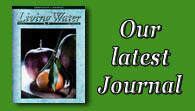One year as our family toured historic Charleston, South Carolina, I noticed that all of the older houses which had been preserved or restored had plaques on their front with symbols and some writing on them. The tour guide explained that these were the marks of the different insurance companies that existed in Charleston when the houses were inhabited. In those days each insurance company had its own fire fighting unit to protect the houses they insured. In case of fire, the fire-fighters would rush to the scene … but they would only battle the fire for houses that displayed their seal. One of these plaques had a sun with its bright, smiling face shining down, as if to say, “There will be no loss here.” Besides this sun, these plaques displayed stars, globes, eagles, and phoenix birds … each symbol signifying the safety of the house.
The Scarlet Cord
When the Israelites came to conquer Jericho, there was only one house whose safety was insured. Only the house of Rahab displayed the seal of protection…a seal far better than any insurance company could give. It had for its symbol and mark of assurance a scarlet cord tied in the window. Joshua 2:21, speaking about Rahab, tells us “She bound the scarlet cord in the window.” This fulfilled the covenant she had made with the two spies she had hidden. These men had made a covenant with Rahab that her life would be spared, and those of her family, if she concealed their secret and tied a scarlet cord in the window.
An Appropriated Covenant
A covenant is a mutual agreement between two people in which each party is bound to fulfill promises on behalf of the other. Rahab had not merely received a promise, she had entered into a covenant with the two spies.
For their part, the spies would tell the army of Israel to look for a scarlet cord in the same window Rahab had used to let them down to safety. When they entered into the battle for Jericho, no soldier was to cause any harm to anyone in the house bearing this symbol.
Rahab had her part of the bargain to fulfill. As she tied up that cord she was saying, “I claim the covenant you have made with me.” Rahab took this covenant to be hers, and she appropriated it by tying the scarlet cord in the window. The covenant was made with her; and she knew it, believed it, and did her small part. She fulfilled the spies request, and displayed the chosen emblem.
In like manner, let us grasp the promises of God by a living faith, and claim them as our own! Jesus Christ gave His own blood that you might be saved. But that blood must be appropriated or He cannot be your Savior. Remember that though Jesus is the Author of faith, He cannot believe for you — you must believe personally for yourself. Some like to point to repentance as the gift of the Holy Spirit, and this is true; but we must not leave the impression that the Holy Spirit repents and the sinner has little or nothing to do with it. The act of repentance is the response of the repenting sinner’s soul to the urging of the Holy Spirit. It takes not only repentance but faith to lay hold of the new covenant that Jesus died to give us, and faith is a personal exercise of the heart, “for with the heart one believes unto righteousness” (Romans 10:10). If we do not repent and believe, Jesus is not ours and we are not His; neither will we obtain any benefit from His life or His death. To lay hold of the covenant that Christ has died to provide, you must tie the scarlet cord in your window, for it will not be tied there for you — you must do it with your own hand. Do you remember when you first said, “Jesus is mine!” and tied a scarlet cord in your window? You apprehended Christ because He had apprehended you. It is my prayer that if you have never done your small part that you will have the boldness to do it now, to say “Yes, I want Jesus to be mine. I dare, with humble confidence, to appropriate His blood for myself since He gives it freely to sinners such as I.”
And so it is with every promise of God. He has done the work, He has paid the price and made the provision, but we must do our small part. We must receive the promise, believe the promise, and intercede for the promise. Having done all, we stand in faith on the promises of God, waiting to see the substance of what we are hoping for. How many of the promises of God remain unfulfilled because they have never been appropriated by faith?
Resting in the Promises
After Rahab tied the line in her window, we do not read that she did anything else, except bring her family under her roof. She did not make preparations to defend the house against the siege, or fortify it from crumbling with the doomed walls of Jericho. She did not show one solitary fear. The scarlet cord was in the window and she felt secure. She had appropriated the promise, and she believed it would not be broken.
What a blessing it is to dwell peacefully and quietly in the finished work of Jesus Christ and the immutable promise of God. Many believers, however, live as though they do not belong to Jesus at all, nor have the blessings of the covenant. Do you think they would doubt whether they were saved in times of temptation if their faith had taken a firm grip of Christ and tied the scarlet cord in the window fast and firm? When their business suffers losses would they be so disillusioned if they really believed that all things are theirs, and if they had appropriated all things by claiming the covenant of grace? Why worry and question ourselves, and go about with a thousand anxieties when salvation’s work was finished on the cross, and Jesus has gone into glory, and carried His perfect work before His Father’s face? Why question our safety when the Lord has raised us up and allowed us to sit together in heavenly places with Him? We who have believed should enter into rest — the peace of God is ours. So by our resting let us show that we have tied the scarlet cord in our window — claiming the finished work of Christ.
An Obedient Believer
Rahab was told to tie the scarlet cord in the window, and that is what she did—there was exact obedience. It was not merely a cord, but a scarlet cord. She did not substitute a blue, or a golden, or a white cord. She did not say “my family line has royalty and so a blue cord to symbolize them would be just as good.” She did not substitute a white cord of purity or a gold cord for the good works she had done. Her trust was not in the color of the cord, but in the covenant that it represented. The covenant called for a scarlet line, and that is what she displayed.
I do not believe that it was an accident, however, that the Lord chose the color scarlet for her seal of assurance. The scarlet cord tied on her window made it appear like the bloody mark on the lintel and doorposts of the houses of the Israelites in Egypt during the first Passover. It was this token which secured the first‑born from the destroying angel. How symbolic that this same appearance would secure the safety of all those in Rahab’s house while the rest of the city of Jericho was destroyed.
It is interesting to note that the scarlet dye of this period was made from the dried body of the female worm coccus ilicis. When the female of the scarlet worm species is ready to give birth to her young, she attaches her body to the trunk of a tree, fixing herself so firmly and permanently that she never leaves again. The eggs deposited beneath her body are protected until they hatch and enter their own life cycle. When the mother dies, the crimson fluid stains her body and the surrounding wood. From the dead bodies of such female scarlet worms, the commercial scarlet dyes were extracted. What a picture this gives of Jesus dying on the cross and shedding His precious blood that He might “bring many sons to glory” (Hebrews 2:10)! He died for us that we might live through Him!
A Scarlet Thread
It should not surprise us that it was a scarlet cord chosen as the emblem of the covenant, for if you read your Bible carefully, you will see a scarlet thread running right through every page of it. The blood commences to flow in Genesis when God made a covering for Adam and Eve from animal skins, and runs through Revelation when Jesus, the Word of God, returns in a robe dipped in blood.
It is unfashionable, nowadays, to speak about the doctrine of atonement through the shed blood of Jesus, the Lamb of God. Modern society sees the blood of Christ more as a blemish than a blessing. And so, some in the Church have “cleaned up” the gospel to make it more polite and acceptable, but in so doing they have removed the blood that cleanses all things. When we remove the blood from the outside to make things “look clean,” what will clean things on the inside? There are many who are “too advanced” to avow the old‑fashioned gospel, but our declaration of faith must be that we believe in the real and literal substitution of Christ, Who died, “the Just for the unjust, that He might bring us to God” (1 Peter 3:18). In the midst of a thousand new gospels, all neat and tidy having removed the blood stains of Christ, we must hold fast to that ancient and true gospel which declares, “without the shedding of blood there is no forgiveness” (Hebrews 9:22). If we try to pull out this scarlet thread, we will soon find that the entire gospel begins to unravel! Take out the scarlet thread of the blood of Christ, and the history and power of the Church are removed with it.
Faithful Obedience
Rahab might have said, “I don’t think it’s essential to tie a piece of line in my window. Can’t I be saved just as well without it, since I believe in the God of Israel? I have faith, and I have shown it by my work in hiding the spies. You cannot suppose that I will perish simply because I have not complied with this regulation about a scarlet cord.” In a similar manner there are many today who inquire whether they may not omit certain duties which they consider to be nonessential to salvation. Instead of walking in God’s perfect will by immediate and complete obedience, they seek “enough” obedience to stay in the Lord’s acceptable will. But obedience does not come in shades of gray, it is black and white — yes or no. The first prophetic word the Lord gave me to speak was in a gathering of leadership for the fellowship I was a part of at that time. As I wrestled with God wanting Him to use someone else (anyone else would do), He spoke clearly to me, “Obey Me, or deny Me!” God didn’t try to understand my inadequacies. He didn’t want my “top ten” reasons for resisting His leading. All He wanted was my obedience. The Lord’s desire and delight in obedience should not surprise us, for He has told us “To obey is better than sacrifice” (1 Samuel 15:22).Rahab’s obedience arose out of real faith. For when she tied the scarlet cord in the window, she expressed her confidence in the fact that Jericho would be destroyed, and she would be saved because she had received a promise to that effect. The writer of Hebrews said it was her faith that rescued her. “By faith Rahab the harlot did not perish with those who were disobedient” (Hebrews 11:31). She would not have hidden the spies if she had not believed in their God. If her faith had failed her, she would not have complied with the covenant’s requirement to hang the scarlet cord in the window. We, too, must obey in faith. The obedience of the slave is worth little; the obedience of the child is precious, for it is the fruit of love. Keeping God’s commands because of a slavish fear of punishment lacks the very heart of obedience, for love is absent. Because we trust in Jesus for the salvation of our souls, it is our joy to do His least desire.
An Open Declaration
Rahab tied the scarlet cord, not in some secret part of the home where others could not see it, but in her window where all could observe. It was her public declaration of faith. This is not to say that everybody understood what she meant by it. It was sufficient that those in secret with her understood. She hung out the red signal from the window, where it could be seen by those who needed to see it. It was not that she wished to attract attention, but she was bound to make a public sign, and she did it.
As believers and followers of Jesus, we, too, are bound to make a public declaration. Jesus said that if we profess Him as Lord before the world, that He would declare us His own before all of heaven. “Therefore whoever confesses Me before men, him I will also confess before My Father Who is in heaven. But whoever denies Me before men, him I will also deny before My Father Who is in heaven” (Matthew 10:32–33).
Jesus was willing to take off His transcendent majesty and become like us. He stepped out of eternity and into time; and then, not only lived as a man but died as a man though He was without sin and undeserving of death. How can we fail to not only confess but proclaim His great love? Let us never be ashamed of the One Who has freed us from all shame! The wonder is that He is not ashamed of us. If He was not ashamed to take our nature upon Himself and die for us, we need never blush to bear His name and exclaim His greatness. Come forward, you trembling ones, tie the scarlet cord in your window, and say, “We are His, and we proclaim it!”
Let us be certain it is the scarlet cord we tie in our window—a declaration of true faith in His precious blood. We must be careful not to confess before the world our church (no matter how grand it might be) nor our doctrine (regardless of how correct it is), but our Lord and the power of His overcoming blood! If Jesus Christ and His substitutionary atonement is your hope, proclaim it — proclaim it boldly, and let there be no mistake about it. Tie the scarlet cord in your window, and if nobody else is pleased with it, the Lord will smile upon you, and you will be a sweet fragrance to Him. In the dead of the night on the first Passover, we do not know if anyone saw the blood upon the lintel and the two side posts in the land of Egypt, but God saw it, and it is written, “When I see the blood, I will pass over you” (Exodus 12:13). When God sees our simple confidence in His dear Son, and perceives us resting upon the cleansing power of Jesus’ blood, He will accept us as His very own and our house shall stand when others fall.
The Mark Upon Our Hearts
Every Christian ought to make their faith in the precious blood visible in many ways. It ought to be evident in our daily conversation. If we are resting in the blood of Jesus, we should be unable to talk for fifteen minutes without people perceiving that we are followers of Jesus. Every Christian ought to be so marked for God that one cannot be with them for long without perceiving that they belong to Him. I wish we were all peculiar people in the respect that the blood‑mark of Christ has set us apart as not our own, but bought with a price. May the Lord grant that it to be so with us!
Whoever we are and wherever we go, we must have the scarlet line hung from the windows of our hearts. Dedicate the whole house of your heart to God — from the upper attic to the very basement. Let not even the smallest room be left which has not been dedicated to Jesus Christ and marked by His blood. Let us be obedient believers, and do our small part by having His blood as the only emblem we are trusting in for safety. In faith, let us declare for all to see our trust in the cleansing power of Jesus’ blood. For only those who have passed through the “red sea” of His blood can come into the promised land of His presence.
All contents of this website are protected under copyright. Living Water Ministry © 2020 All rights reserved.
www.livingwaterministry.net



